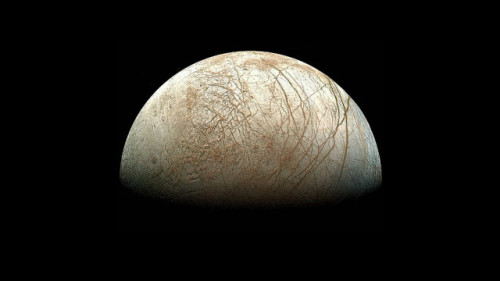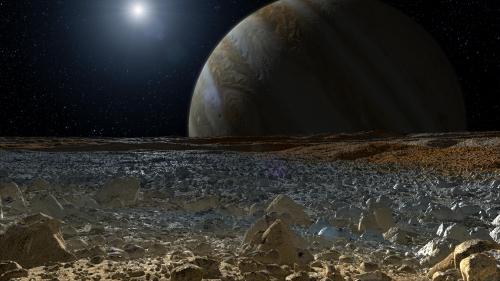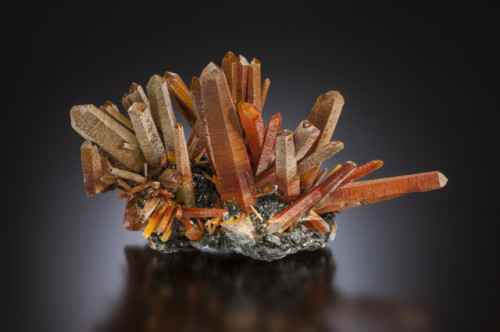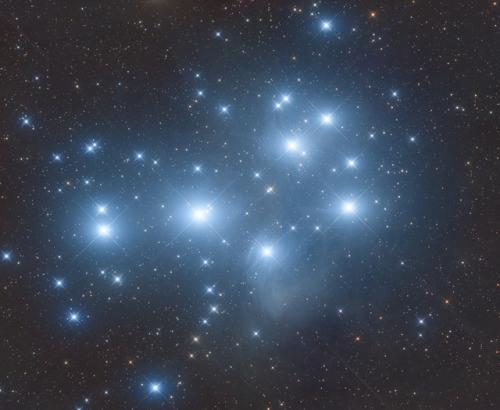Latest Posts by tres-4b-blog - Page 4

Like a paintbrush caressing the rings of Saturn, wee moon Daphnis has just enough gravity to make a ripple. (at NASA’s Cassini Mission to Saturn)

Mission Control. It appears to be the profile & vest of Flight Director Gene Kranz at the helm. Mission Control is located at the Johnson Space Center, established in 1961 & renamed after President Lyndon Johnson in 1973. The JSC covers 1620 acres & 100 buildings. Flights from Project Gemini (following Gemini 3), Apollo, Skylab, Apollo–Soyuz & the Space Shuttle were monitored from here.

Violent Collision of Two Neutron Stars Occurred near Pre-Solar Nebula 4.6 Billion Years Ago
http://www.sci-news.com/astronomy/collision-two-neutron-stars-pre-solar-nebula-07154.html


NASA plans a robotic mission to search for life on Europa | io9
It looks like it’s finally going to happen, an actual mission to Jupiter’s icy moon Europa — one of the the solar system’s best candidates for hosting alien life.
Yesterday, NASA announced an injection of $17.5 billion from the federal government (down by $1.2 billion from its 2010 peak). Of this, $15 million will be allocated for “pre-formulation” work on a mission to Europa, with plans to make detailed observations from orbit and possibly sample its interior oceans with a robotic probe. Mission details are sparse, but if all goes well, it could be launched by 2025 and arriving in the early 2030s.
This is incredibly exciting. Recent evidence points to a reasonable chance of habitability. Its massive subsurface ocean contains almost twice as much water as found on Earth. The water is kept in liquid state owing to the gravitational forces exerted by Jupiter and the moon’s turbulent global ocean currents. The good news is that a probe may not have to dig very deep to conduct its search for life; the moon’s massive plumes are ejecting water directly onto the surface.
[Read more]
friendly reminder to close tumblr and start studying
Chris Hadfield: What I learned from going blind in space
There’s an astronaut saying: In space, “there is no problem so bad that you can’t make it worse.” So how do you deal with the complexity, the sheer pressure, of dealing with dangerous and scary situations? Retired colonel Chris Hadfield paints a vivid portrait of how to be prepared for the worst in space (and life) – and it starts with walking into a spider’s web. Watch for a special space-y performance.










SpaceTime 20190503 Series 22 Episode 34 is now out
SpaceTime covers the latest news in astronomy & space sciences.
The show is available as a free twice weekly podcast through Apple Podcasts (itunes), Stitcher, Google Podcast, Pocketcasts, SoundCloud, Bitez.com, YouTube, Audio Boom, your favourite podcast download provider, and from www.spacetimewithstuartgary.com
SpaceTime is also broadcast coast to coast across the United States on Science360 Radio by the National Science Foundation in Washington D.C. and around the world on Tune-In Radio.
SpaceTime daily news blog: http://spacetimewithstuartgary.tumblr.com/ SpaceTime facebook: www.facebook.com/spacetimewithstuartgary SpaceTime Instagram @spacetimewithstuartgary SpaceTime twitter feed @stuartgary SpaceTime YouTube: https://www.youtube.com/c/SpaceTimewithStuartGary
Today’s stories…
First results from ExoMars Trace Gas Orbiter During its first year in orbit the ExoMars Trace Gas Orbiter has made some surprizing discoveries about the impact of the recent global Martian dust storm and an apparent lack of methane in the red planet’s atmosphere.
Dragon spacecraft destroyed in dramatic explosion The first crew Dragon two capsule which successfully flew to the International Space Station in March has been destroyed in a major explosion at the Cape Canaveral air force station in Florida.
Stratolaunch test flight Stratolaunch has successfully undertaken the first test flight of the company’s behemoth twin fuselage six engine jetliner designed to launch satellites into space.
May Skywatch We tour the night skies of May which play host to the annual Eta-Aquarids meteor shower generated by Halley’s Comet.
Last Wednesday’s show…
New model for Nova explosions Scientists will need to go back to the drawing board to come up with new ways in which powerful explosions – known as novae – can occur on the surfaces of white dwarf stars.
Explaining super-luminous novae Astronomers have discovered that shockwaves generated during nova explosions can dramatically amplify their power and brightness.
NASA’s InSight Detects First Likely ‘Quake’ on Mars NASA’s Mars InSight lander has measured and recorded for the first time ever a likely “marsquake.”
New physics needed to explain differences in the Hubble Constant New observations are showing that differences in how fast the universe is expanding now compared to how fast it was expanding billions of years ago are no statistical accident.
The Science Report Climate change is now threatening the world’s doomsday vault. The world’s second largest colony of emperor penguins almost wiped out. Extreme ocean winds and wave heights are increasing around the globe. A small bone behind the knee, which was once rare in humans is becoming more common. Palaeontologists have unearthed a new species of hadrosaur dinosaur in Mongolia. History revisionists spewing lies and cherry-picked half-truths for racist and political propaganda
SpaceTime Background SpaceTime is Australia’s most respected astronomy and space science news program. The show reports on the latest stories and discoveries making news in astronomy, astrophysics, cosmology, planetary science, galactic and stellar evolution, physics, spaceflight, and general science. SpaceTime features interviews with leading Australian scientists about their latest research. The show is broadcast coast to coast across the United States by the National Science Foundation on Science360 Radio and around the world on Tune in Radio. SpaceTime is available in Australia as a twice weekly podcast which averages around three million downloads annually. It’s hosted on line through Bitez.com on all major podcast platforms. SpaceTime began life in 1995 as ‘StarStuff’ on ABC NewsRadio. Stuart Gary created the show while he was NewsRadio’s Science Editor, evening presenter, and news anchor (a position he held for more than 17 years). Gary wrote, produced and hosted StarStuff, consistently achieving 9 percent of the Australian radio audience share - according to Neilsen ratings survey figures for the five major Australian metro markets (Sydney, Melbourne, Brisbane, Adelaide, & Perth). The StarStuff podcast was hosted by ABC Science on line achieving over 1.3 million downloads annually. Sadly, the popular program was axed in 2015 during ABC budget cuts. Rather than remain with the ABC, Gary resigned to continue producing the show independently and rebranding it as SpaceTime. The first episode of SpaceTime was broadcast on February 8th 2016 and the show has been in continuous production ever since. SpaceTime now reaches an audience almost three times greater that it achieved as StarStuff and continues to grow.

The required escape velocity of each planet.⠀⠀
(Sorry, no Kilometers 😥😥) ⠀⠀Via NASA

Hematite Quartz
Locality: Jinlong hill, Longchuan Co. (Lungchuan Co.), Heyuan, Guangdong, China
Size:14.5 cm
2019 May 6
Virtual Flyby of the Whirlpool Galaxy Video Credit: F. Summers, J. DePasquale, and D. Player (STScI); Music: Into the Wormhole (Jingle Punks via Youtube)
Explanation: What would it look like to fly over a spiral galaxy? To help visualize this, astronomers and animators at the Space Telescope Science Institute computed a virtual flyby of the Whirlpool Galaxy (M51) using data and images from the Hubble Space Telescope. At only 25 million light years distant and fully 50 thousand light years across, the Whirlpool is one of the brightest and most picturesque galaxies on the sky. Visible during the virtual flyby are spiral arms dominated by young blue stars, older lighter-colored stars, dark lanes of dust, and bright red emission nebulae. Many galaxies far in the distance can be seen right through M51. The visualization should be considered a time-lapse, because otherwise the speed of the virtual camera would need to be very near the speed of light.
∞ Source: apod.nasa.gov/apod/ap190506.html




























